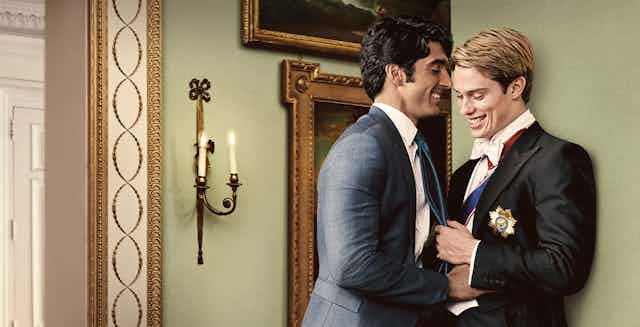Warning: contains spoilers for Red, White & Royal Blue.
Global interest in the British royals has increased in recent years, thanks, in part, to the prominent romance between Prince Harry and Meghan Markle. So, it is perhaps not surprising that Amazon Prime’s new queer romantic comedy, Red, White & Royal Blue, has taken social media by storm.
The feature-length romcom follows Alex Claremont-Diaz, son of the first female US president (played by Uma Thurman), and Prince Henry Fox-Mountchristen-Windsor, who is fourth in line to the British throne, as they fall in love. Based on the 2019 novel by Casey McQuiston, the film follows the enemies-to-lovers trope, and starts off by showing off the protagonists’ dislike for each other.
After an antagonistic encounter at the wedding of Prince Henry’s brother that results in the destruction of a £75,000 cake, the pair are brought together by their respective governments in the name of damage limitation. Their shenanigans are considered a risk to the intense trade deal negotiations that are going on between the US and UK.
A ‘special relationship’
Once forced to spend time together, they fall in love. Henry (played by Nicholas Galitzine) and Alex (Taylor Zakhar Perez) try to make their budding romance work over long distance and amid pressure to keep their relationship a secret. Cultural differences and stereotypes between the Englishman and American are at the heart of the film’s humour, and play a significant role in the development of their relationship.
In line with national stereotypes, American Alex is outgoing and confident, while Prince Henry is quieter and emotionally repressed. During their enforced media tour, Henry states that “Alex has very strong opinions, and he shares them loudly”. Once they fall in love, Alex recalls how Prince Henry “grabbed my hair in a way that made me understand the difference between rugby and football”.
The film is the most recent iteration in a long tradition of romances that negotiate the “special relationship” between the UK and US.

Coined by Winston Churchill in 1946, this refers to the close economic, political and military ties between the two nations. The treatment of personal US-UK relationships in popular culture is symbolic of the wider political foibles, tensions and connections between the two countries – as quips about Brexit in Red White & Royal Blue demonstrate.
Generally, these romantic depictions are heterosexual, as seen in Notting Hill (1999), Serendipity (2001) and The Holiday (2006), for example. The focus on a queer relationship here is thus a welcome addition to the romantic US-UK canon.
Their different approaches to politics and public life is what temporarily breaks up the young couple. Both worry about the political impact of their coming out. Alex is concerned about a negative effect on his mother’s chance for re-election – a bisexual son potentially scaring away conservative voters in key swing states. Henry is painfully aware of his role as prince and “belonging” to the British public, who may not be able to consolidate the tradition of the monarchy with the image of a gay royal.
That each sees his role so differently emphasises the contrasting systems of government of the countries in which they grew up. While Alex is dedicated to politics beyond his position as First Son (he’s ambitious and keen to work on the ground to make a difference), Henry is both imprisoned by his involuntary public position and disillusioned by the role of the British monarchy. He wonders “if what we do has any meaningful impact on people’s lives”.
As Alex voluntarily seeks an enduring, more prominent role in public life, Henry worries about the reception his sexuality will get in the UK. He fears further intrusion in his life as a result of Alex’s political ambitions.
The film’s ending resolves these tensions. The monarchy is portrayed as an outdated and homophobic institution. The king (Stephen Fry) suggests the nation won’t accept a gay prince – only to be proved wrong a minute later, as crowds gather outside Buckingham Palace waving pride flags and offering support for Prince Henry. Across the Atlantic, Claremont wins re-election by flipping Texas.
As a modern, queer exploration of the “special relationship”, the film encourages audiences to reflect on what unites and divides both countries, from politics to personal relationships. At a time when both sides of the Atlantic see legislative and discursive challenges to LGBTQ+ rights, the film may not provide a systematic critique of queer repression, but it does offer a welcome dose of charming (if perhaps over-optimistic) political escapism.

Looking for something good? Cut through the noise with a carefully curated selection of the latest releases, live events and exhibitions, straight to your inbox every fortnight, on Fridays. Sign up here.

